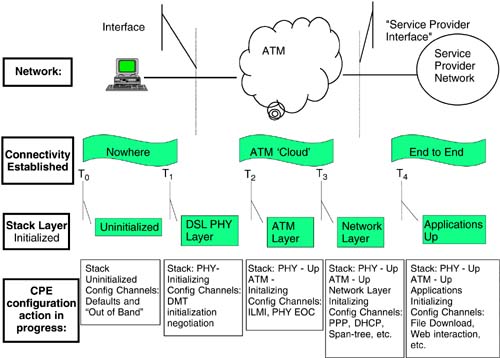13.2 Relationship Between the Stack, the Network, and the CPE Configuration
| A management architecture for DSL CPE, which meets the requirements mentioned above, can be built based on the observation that communications between the customer's equipment and the services available over a DSL network progress deeper into the network as each layer of the communication stack initializes. As the CPE initializes its communications protocol stack, it is able to receive configuration information from the part of the network that it is currently able to communicate with. The particular place in the network that the CPE has "reached" at any time during the initialization has the information that is required to get to the next further place in the network. The configuration tools associated with the protocol being initialized at that particular stage of the initialization process can be used to initialize the CPE. The network elements that initialize the CPE at that stage can be expected to have the specific protocol parameters required to initialize that particular layer of the protocol stack. Figure 13.2 illustrates this principle. Figure 13.2. Progressive initialization of DSL CPE. At time "T0" the connection between the customer premises and the network is completely uninitialized . There are no paths over the network established where any configuration information can be transported to the CPE from over the network. At time "T1" the DSL Physical Layer (PHY) is initializing. The CPE is communicating with the edge of the carrier's network (to the DSLAM). The initialization features of the PHY interface protocol allow for the exchange of PHY configuration information. At the end of this stage, the CPE can communicate with the edge of the carrier's core network (the DSLAM). Assuming that the core network is ATM based, at "T2" the CPE is able to begin bringing up its ATM layer. Because communication is being established to the ATM elements in the carrier's network (of which the DSLAM is typically the one closest to the subscriber), information can be passed to the CPE about the configuration of the ATM layer from these elements via the ATM ILMI (integrated local management interface) [1] the standard configuration interface for an ATM link. In the case of the use of other link level protocols, such as frame relay, the initialization tools provided with those protocols can provide the CPE with the appropriate parameters from the network elements. When time "T3" is reached, the CPE has established communications with the far side of the carrier's core network. The network protocols (such as IP) can now be initialized over the ATM connections that have been established. At "T4" the CPE has been configured with the information required to utilize its protocol stack to communicate with the service provider at the far end of the network. Specific applications can now be initialized over this end-to-end service. This philosophy of configuration supports most of the requirements named earlier. There are several primary advantages of this view of initialization:
|
| Top |
EAN: 2147483647
Pages: 154
